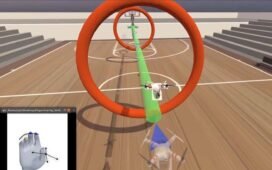
A scene from an AI-generated facsimile of the computer game Doom
id software
An AI-generated recreation of the classic computer game Doom can be played normally despite having no computer code or graphics. Researchers behind the project say similar AI models could be used to create games from scratch in the future, just as they create text and images today.
The model, called GameNGen, was made by Dani Valevski at Google Research and his colleagues, who declined to speak to New Scientist. According to their paper on the research, the AI can be played for up to 20 seconds while retaining all the features of the original, such as scores, ammunition levels and map layouts. Players can attack enemies, open doors and interact with the environment as usual.
After this period, the model begins to run out of memory and the illusion falls apart.
The original Doom was released in 1993 and has become a popular subject for computer science projects in the years since, including attempts to get it running on unusual and limited hardware such as toasters, treadmills and espresso machines.
But in all those cases, the hardware is simply running the original game’s code. What GameNGen does is fundamentally different: a type of AI called a neural network has learned by observation how to recreate the game without seeing any of its code.
The researchers first created an AI model that learned to interact with Doom as a human would. That model was then tasked with playing the game over and over again while a second AI model, based on the Stable Diffusion image generator, learned how hundreds of millions of inputs resulted in changes in the game state.
That second model essentially then became a copy of the game, with all of the knowledge, rules and instructions from the original code encoded in the mysterious network of artificial neurons in its own architecture. In tests, human players were only slightly better than random chance at distinguishing short clips of the game from clips of the AI simulation.
GameNGen’s creators claim in their paper that it is a proof-of-concept for games being created by a neural network rather than lines of code. They suggest that games could be generated from text descriptions or concept art, which would make production less costly than using human programmers.
Andrew Rogoyski at the University of Surrey, UK, says the idea of getting a neural network to hallucinate a game environment, and the interactions a human has with it, is an interesting step forward, but not one that will replace human game designers.
“I don’t think it’s the end of those game studios. I think what the game studios have is the imagination, the skills, to actually create these worlds, to understand gameplay, to understand engagement, understand how to draw us into a story. It’s not just the nuts and bolts, the bits and bytes,” he says. “There’s something very human about creating engaging experiences that we as human beings enjoy that, at the moment, and for the foreseeable future, will largely come from other human beings.”
Topics:








